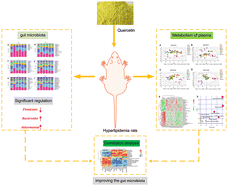Analysis of the mechanism of action of quercetin in the treatment of hyperlipidemia based on metabolomics and intestinal flora
Abstract
Hyperlipidemia (HLP) is one of the main factors leading to cardiovascular diseases. Quercetin (QUE) is a naturally occurring polyhydroxy flavonoid compound that has a wide range of pharmacological effects. However, the potential mechanism for treating HLP remains unclear. Thus, the study aimed to investigate the role of QUE in HLP development and its underlying mechanisms in HLP rats based on the analysis of gut microbiota and plasma metabolomics. Following the establishment of an HLP model in rats, QUE was orally administered. Plasma samples and fecal samples were collected from HLP rats for microbiome 16S rDNA sequencing and metabolic UPLC-Q-Exactive-MS analysis. The results suggested that QUE could regulate dyslipidemia and inhibit the levels of TC, TG, and LDL-c. Additionally, histopathological findings revealed that QUE could reduce lipid deposition, ameliorate hepatic injury and steatosis in HFD-induced rats, and have a protective effect on the liver. The analysis and identification of plasma metabolomics showed that the intervention effect of QUE on HLP rats was related to 60 differential metabolites and signal pathways such as lactosamine, 11b-hydroxyprogesterone, arachidonic acid, glycerophospholipid, sphingolipid, glycerolipid, and linoleic acid metabolism. Combined with fecal microbiological analysis, it was found that QUE could significantly change the composition of intestinal flora in HLP rats, increase beneficial bacteria, and reduce the composition of harmful bacteria, attenuating the Firmicutes/Bacteroidetes ratio. The results of correlation analysis showed that the relative abundance level of Firmicutes, Deironobacterium, Fusobacterium, Bacteroides, and Escherichia coli was closely related to the change of differential metabolites. In summary, combined with metabolomics and gut microbiota studies, it is found that QUE can reduce lipid levels and improve liver function. The potential mechanism may be the regulation of metabolism and intestinal flora that play a role in reducing lipid levels, to achieve the purpose of treatment of HLP.



 Please wait while we load your content...
Please wait while we load your content...